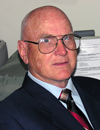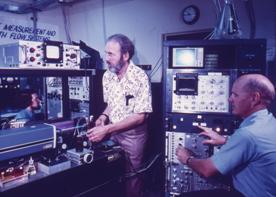Home Cytometry History Individual Histories Philip N. Dean

Philip N. Dean

Philip Dean began his career in the Air Force as a specialist in the field of Radiation Biology. Following discharged from active duty, he started work at the Los Alamos National Laboratory where he became involved with the Flow Cytometry Group. It was also at this time that he developed methods and software for the analysis of DNA distributions. Subsequently, Phil Dean transferred to the Biomedical Research Program at Lawrence Livermore National Laboratory, where he continued to work on the development of flow cytometry and cell sorter instruments as well as data analysis software, as well as project begun at Los Alamos, to develop an anthropometric phantom to calibrate detectors used for the measurement of plutonium in the human lung. With the help of the Hazards Control Department, he completed the project, which resulted in the standard phantom used throughout the world for this purpose.

Joe Gray with early flow cytometer developed at LLNL
He participated in the development of multi-parameter cell sorting and its use in flow karyotyping and the sorting of single chromosome types, as well as indexed sorting. In data analysis, he developed a method for the analysis of dual-parameter data on chromosomes. More recently his efforts expanded into image cytometry where his specialty was in optical sectioning and 3D reconstruction.

Marv Van Dilla and Phil Dean at dual beam cell corter developed at LLNL – first ever measurement and sorting of chromosomes.
In June, 1997, the ISAC Council established the positions of ISAC Historian, and ISAC Archivist. Longtime member Philip Dean, who had been fulfilling these roles unofficially, was appointed to both positions. Since that time, he has continued to play an important role in documenting the events and business of the Society. He also reviewed old records, and wrote an extensive history of the Society, and analysed and summarized statistics on membership and international diversity. Much of the material on the ISAC Wall of History and on the ISAC website is based upon his work, and we gratefully acknowledge his efforts to preserve the history of the society for future members.
